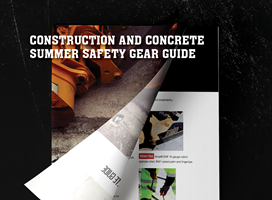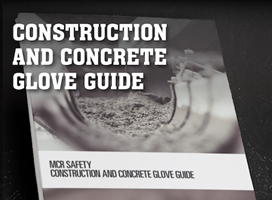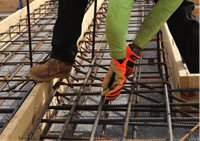Construction and concrete work is dangerous. Of the 250,000 employees who work in concrete manufacturing, 10% of them have been injured and about 42 of those people die every year.
On top of the hazards that are common to any manufacturing operation, like material handling and personnel risks, concrete work poses numerous health and safety hazards. These range from heat exposure, wet cement, abrasive materials, chemical burns, confined spaces, sharp objects, weather and many others.
To prevent all the worst-case scenarios that can happen, companies must follow best practices for safety. Here’s a look at 10 safety tips that will preserve the health of your employees and make your company a safe place to work.
Tip #1: Conduct a Hazard Analysis
Without knowing where things currently stand, it’s almost impossible to make effective changes. According to the Occupational Safety and Health Administration (OSHA), the first and most important step is conducting a comprehensive safety and health analysis, with the goal of making a list of all hazards at the worksite.
After making a hazard list, address each issue step by step. Aim to meet or exceed industry safety standards. Conduct additional hazard analysis programs on a regular basis - annually, at minimum.
MCR Safety’s construction and concrete industry pages highlight many of the hazards workers face. These pages serve as an excellent tool for breaking down the safety gear one should consider when on a worksite.
Tip #2: Establish a Written Safety Plan
Many concrete operations assume that casual chats and verbal instructions are enough to keep everyone safe. Research shows that this is not the case. A written safety plan is a critical part of worker safety, because it clarifies numerous areas of concern that might not otherwise be discussed in casual conversation.
In fact, workers have a right to be protected from workplace hazards and notified about employer protocols. By failing to provide a written plan, a concrete company puts itself at legal and financial risk, not to mention risking the harm of its employees.
Before writing out your official safety plan, be sure to have an Onsite Hazard Assessment completed. We will thoroughly analyze all the hazards your company faces and make PPE recommendations.

Let’s get you a 360 Assessment scheduled and keep your employees safe!
Tip #3: Hold Regular Training Sessions
Training is an important part of concrete manufacturing safety. Many operations train employees how to do the job at hand, but neglect to conduct regular safety training.
A comprehensive training program includes all of the following concepts:
- A clear path to safe practices in every work activity
- Procedures for operating equipment safely
- Established steps for cleaning, maintaining, and replacing tools and equipment
- A response plan for sudden hazards and emergencies
- First aid training
At MCR Safety, we practice what we recommend. MCR Safety employees regularly conduct CPR training, safety awareness training, OSHA 10 training, two weeks of initial training and 40-50 hours of ongoing yearly training.
Tip #4: Use Personal Protective Equipment
Personal Protective Equipment (PPE) is a huge part of construction and concrete safety. Because of concrete’s inherent risk to the skin and respiratory system, employers have a responsibility to protect employees.
Here’s a list of the basic PPE you should provide:
- Respirators
- Abrasive coated gloves for handling concrete blocks, grinding, chipping, brushing, and scraping
- Eyewear for flying debris
- Gloves rated for chemical exposure, impact protection, cutting, and burning, as required by certain tasks
- Goggles for chemicals and dust
- Impact protection gloves
- Protective clothing – Rainwear, Vests, Long sleeve shirts
- Protective footwear, such as steel toed PVC boots
- Task-specific PPE worn during repair and cleaning
Tip #5: Set a Maintenance and Replacement Schedule
Dangerous equipment creates a dangerous environment. Too often, manufacturing companies wait until equipment is at the absolute end of its usable life before replacing it. This leaves room for worker accidents and injuries.
Instead, set a regular schedule for monitoring, maintenance, and replacement of concrete manufacturing equipment and tools. Research the manufacturer’s end-of-life recommendation and avoid coming too close to it. This includes large equipment like forklifts, cranes, hoists, and rigging. Everything should be inspected by trained, competent safety specialists.
Tip #6: Use Proper Guards and Lockout/Tagout Procedures
Poor lockout and tagout procedures are the second most frequent OSHA hazard citation. They’re also a top contributor to worker accidents and injuries.
Lockout/tagout procedures should be used to de-energize conveyors and other machinery before attempting to free clogs and jams. All chutes and hatches should remain secured, to prevent injuries from swinging parts. Guards should protect workers’ bodies from moving machinery, and should never be removed as a workaround to proper use.
Tip #7: Install HEPA Vacuums and Environmental Protections
Environmental dust and inhalants pose a major hazard to workers’ lungs and respiratory systems. Loose debris, blowing dust, and splattering concrete can also harm workers’ eyes, causing permanent damage.
In many concrete manufacturing tasks, it is advisable to wear full-cover goggles or safety glasses with side shields. Respirators and assisted breathing devices may be necessary in areas of heavy dust. HEPA vacuums and dust-removal systems are highly recommended.
As we discussed in our blog covering the new Silica Dust Rule, dust is a major concern for construction and concrete workers. Our HK3 glasses are an ideal solution for working around dust.
Be sure to check out our eyewear protection page, which highlights our entire range of protective eyewear.
Tip #8: Eliminate Tripping and Falling Hazards
OSHA reports that 15% of all accidental deaths in industrial workplaces are caused by falls. Each year, these accidents contribute to more than $12 billion in health care and disability costs to U.S. employers.
Avoid slips, trip, and falls by taking these precautions:
- Don’t allow spills to remain in place – quickly clean them up
- Keep clutter and debris away from main walkways
- Fit doors, drawers, and cabinets with auto-closers to prevent obstacles
- Use safety tape to cover exposed cords and cables
- Add abrasive floor mats for traction and replace worn flooring urgently
- Consider providing proper footwear to reduce ill-fitting shoe risks
- Seek expert help in designing areas with ladders, forklifts, and tall storage shelves
- Provide handrails and hand-holds in areas with poor balance
- Allow workers plenty of time for concrete manufacturing tasks, to avoid risky motions like running and rushing
Tip #9: Make Ergonomic Practices a Priority
Like many industrial settings, concrete work holds ergonomic hazards. Repetitive motions, confined spaces and awkward positions can cause body-wide musculoskeletal injuries for workers.
Reduce or eliminate tasks that involve twisting, turning, vibration, and heavy lifting. Consider using machines and automation for tasks that involve repetition. Add conveyors, dollies, hand trucks, and vehicles that can take these burdens off humans - particularly when it comes to bending and lifting.
Tip #10: Create a Culture of Safety
In some ways, this is the most difficult safety task of them all: creating a safety culture at your company. It’s easy to get caught up in day-to-day work and forget about the importance of safety.
Safe cultures embrace change. Have leaders set a good example by welcoming feedback, continuously monitoring their environment, and updating their policies as necessary. Move your operation toward a culture of safety and you’ll see hazards minimized over the long term.
MCR Safety Helps Concrete Manufacturers Stay Safe
As mentioned above, be sure to check out the concrete section. Whether you need gloves, glasses, or garments, we have you covered!
We Protect People!

Summer Construction and Concrete Guide
Get industry leading information for what products work best when dealing with concrete in the summer heat.

Construction and Concrete Glove Guide
Choosing the right gloves is a critical safety step. This is even more true for concrete workers.
About the Author
Related Articles

Concrete Safety Gear Checklist
Concrete workers understand that while concrete is used everywhere, from private homes to modern...
How to Treat Cement Burns
The United States produced 83.5 million tons of Portland cement in 2017, and imported even more.Latest Articles








